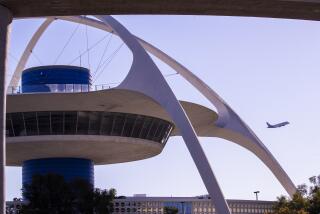False Alarm Led Jetliner to Abort Landing
- Share via
VAN NUYS — Aviation equipment being tested on the ground at Van Nuys Airport was blamed Thursday for accidentally triggering an alarm aboard a commercial jetliner, causing it to take immediate evasive action and abort a landing.
The Federal Aviation Administration has opened an investigation into the incident, which disrupted Southwest Airlines Flight 1451 with 56 passengers and five crew aboard Jan. 9.
The Boeing 737 jetliner later landed without incident at its scheduled destination, Burbank Airport.
The plane was making a routine approach to Burbank Airport when an alarm sounded in the cockpit, warning of a possible imminent midair collision.
The warning came from an on-board, computerized radar device--a Traffic Alert and Collision Avoidance System, known as TCAS--designed to notify the cockpit crew if the plane appears to be on a collision course with another aircraft.
Pilots complied with the warning, interrupted the landing approach, climbed and veered to the right.
The crew then called air traffic controllers at Burbank Airport to ask where the other plane was, Southwest spokeswoman Kirsten Kendrick said. She said controllers said there were two other planes--both of them smaller, prop-driven aircraft--flying in the area, but that neither appeared dangerously close.
As officials reconstructed the event, Flight 1451 had taken off from Las Vegas on the morning of Jan. 9, was directed west to the Simi Valley area and made a U-turn, lining up for a west-to-east landing at Burbank Airport.
Mitch Barker, spokesman for the FAA, said the jetliner was about two miles west of the airport, descending through 3,000 feet at about 10:50 a.m., when the alarm went off.
Kendrick said the transmitter that apparently triggered it was a transponder, which enhances the image of an airplane on radar screens by adding a readout of its altitude and a code identifying the aircraft.
The FAA declined to state who activated the transponder at Van Nuys Airport, which is about five miles from Burbank Airport.
Barker said that at the time the alarm sounded, one of the other aircraft--an air taxi--was about two miles east of Burbank Airport at an altitude of 4,000 feet. He said the third aircraft, a twin-engine corporate aircraft, was westbound at 5,000 feet, but he did not know its precise location.
The Southwest jet turned south and climbed to an altitude of 4,600 feet. Air controllers directed the Ameriflight corporate plane to climb to 6,000 feet.
Kendrick said none of the planes came dangerously close to one another--”As far as I know, the separation was adequate.”
Kendrick said she was told the pilot of the corporate aircraft said his plane was “bounced around a bit” as it apparently crossed the wake of the Boeing jetliner.
However, John Hazlett, vice president of maintenance at Ameriflight, strongly denied reports that the company’s plane, used as a freight transporter, came close to the jetliner.
“I talked to the captain myself, and he frankly didn’t even remember the whole thing, it was so uneventful,” Hazlett said. “There was no turbulence. It was not buffeted around.”
Encounters with wake turbulence, which can last for several minutes behind a large plane, are not that unusual in crowded air space. The turbulence, when dangerously strong, can upset smaller aircraft, and pilots of light planes are warned to avoid it whenever possible.
Barker said that when controllers determined that conditions were safe, the jetliner descended to 4,000 feet and then completed a routine landing.
The FAA began an investigation to determine if the testing of a transponder, which emits a signal from an aircraft to other aircraft and to radar, was being properly conducted.
Generally, a transponder is turned on during flight and off for landings and takeoffs. However, there is a complex set of rules for testing them while on the ground, said Barker.
The investigation is being conducted by the FAA Flight Standards Office in Van Nuys.
Barker said the incident “has not been classified as a near-midair collision.” He said an investigation is continuing to determine how close the three planes came to one another.
Staff writer Andrew Blankstein contributed to this story.
More to Read
Sign up for Essential California
The most important California stories and recommendations in your inbox every morning.
You may occasionally receive promotional content from the Los Angeles Times.













